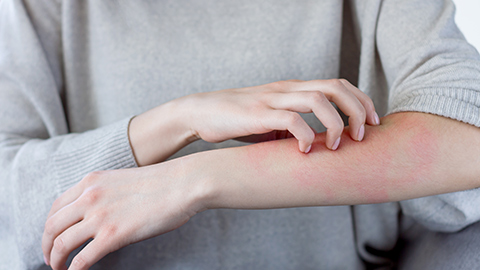10/07/2021

A client has a panoply of health challenges, but the main one for right now is mast cell activation syndrome. Her whole body is primed to have an allergic reaction—to lotion, to smells, maybe even to touch. Is it possible to create a safe way for her to receive massage?

Dermatographism on forearm of a 19 year old college student.


This podcast sponsored by:
About Anatomy Trains:
Anatomy Trains is a global leader in online anatomy education and also provides in-classroom certification programs for structural integration in the US, Canada, Australia, Europe, Japan, and China, as well as fresh-tissue cadaver dissection labs and weekend courses. The work of Anatomy Trains originated with founder Tom Myers, who mapped the human body into 13 myofascial meridians in his original book, currently in its fourth edition and translated into 12 languages. The principles of Anatomy Trains are used by osteopaths, physical therapists, bodyworkers, massage therapists, personal trainers, yoga, Pilates, Gyrotonics, and other body-minded manual therapists and movement professionals. Anatomy Trains inspires these practitioners to work with holistic anatomy in treating system-wide patterns to provide improved client outcomes in terms of structure and function.
Website: anatomytrains.com
Email: info@anatomytrains.com
Facebook: facebook.com/AnatomyTrains
Instagram: instagram.com/anatomytrainsofficial
0:00:00.0 Speaker 1: Ruth Werner's best-selling book, A Massage Therapist's Guide to Pathology, is a highly regarded comprehensive resource that sets the standard for pathology education. Written for massage therapy students and practitioners, this ground-breaking resource serves up a comprehensive review of the pathophysiology, signs, symptoms, and treatment of more than 500 diseases and disorders. Learn more at booksofdiscovery.com.
0:00:32.7 Speaker 2: Anatomy Trains is delighted to announce a brand new dissection live stream specialty class on September 18th, lumbopelvic stability, a one-day layer dissection with Anatomy Trains author Tom Myers and master dissector Todd Garcia. The early bird price of $150 is held until September 10th; after September 10th, the price is $250. Come see the body's actual core for yourself. This course will be provided over Zoom webinar with multiple camera views, live chat and Q&A. Visit anatomytrains.com to sign up.
[music]
0:01:15.4 Ruth Werner: Hi, and welcome to "I Have a Client Who... " pathology conversations with Ruth Werner, the podcast where I will discuss your real life stories about clients with conditions that are perplexing or confusing. I'm Ruth Werner, author of A Massage Therapist's Guide to Pathology, and I have spent decades studying, writing about and teaching about where massage therapy intersects with diseases and conditions that might limit our client's health. We almost always have something good to offer even with our most challenged clients, but we need to figure out a way to do that safely, effectively, and within our scope of practice, and sometimes as we have all learned, that is harder than it looks. Today's episode comes to us from a massage therapist in Florida who was working with some pretty complex situations. In this case, I had a chance to learn some new things and to add to my understanding of how best to time massage therapy around certain common medications. Are you interested? Listen on.
0:02:23.1 RW: She says, my question is about mast cell activation and massage. I've not found much information about it, but I know enough to proceed with caution. In addition to mast cell activation syndrome, this client has Ehlers-Danlos since birth, was diagnosed with dysautonomia around 2011, POTS, that's positional orthostatic tachycardia syndrome in 2017, and mast cell activation syndrome in 2020. In the last 18 months, she's racked up a long list of food and environmental issues that are problems and medications that she has a reaction to. Thankfully, none of these have been a full blown anaphylaxis response. My husband also has a complicated situation with a history of idiopathic allergic reactions. There have been a handful of times in the past when I've given him massage when unbeknownst to us, he was already brewing an allergic reaction and the massage just sent him over the edge into full blown hives from head to toe. That started my path on understanding histamine and the body some more. I learned about h1 and h2 receptors and now both liquid Benadryl and Pepcid have a permanent place in our home.
0:03:34.2 RW: Okay, so there's a lot to unpack here and I didn't even include all of our correspondence. Some of what we'll talk about today involves, gulp, chemistry. I don't have the expertise to do a deep dive into the details of the situation, but I can help us at least get our feet wet enough to come to some conclusions about massage therapy. Before we talk about mast cell activation disorder, or mast cell activation syndrome, let's talk about mast cells. Mast cells are immune system cells mostly located, among other places, in connective tissues, including superficial fascia. They are deeply involved in wound healing and inflammation, including inflammation related to allergies. And you will recall that an allergic reaction is an immune system response to some trigger that is not actually inherently dangerous. There's nothing deadly about bee venom or peanut butter. But if you have an immune system that thinks these things are trying to kill you, then the immune and inflammatory responses to those triggers can be life threatening, and mast cells are responsible for part of that overreaction.
0:04:50.8 RW: Some triggers for mast cell activation can include pathogens and allergens and physical trauma. When mast cells are activated, they release chemicals called mediators. These chemicals induce inflammation, and it can happen relatively slowly or it can happen really, really fast and that can be dangerous. Among the dozens of different mediators that mast cells release, we can find this thing called histamine. And that's a familiar word, right? So mast cell activation disorders is a group of problems involving issues with mast cell activity. Mast cell activation syndrome, which is what we're dealing with in this case, is just one of those mast cell activation disorders. So in this situation, mast cells release these chemical mediators, including lots of histamine, but without any infection or trauma. In other words, allergies, sometimes to an unknown or unidentified allergen, go crazy.
0:05:57.2 RW: Common symptoms of mast cell activation syndrome include flushing, hives, wheels, bruising, itching, a burning sensation in the skin and a situation called dermatographism. Ooh, let's take that apart. Dermato, skin; graphism, writing. This describes a reaction in the skin or even gentle scratching can cause the skin to develop these raised itchy wheels. You can trace a word or some shapes lightly on the skin and a few minutes later, you'll be able to read what you wrote. I will put a picture in the show notes. In addition to all these skin things, mast cell activation syndrome can cause lightheadedness, dizziness, changes in heart rate, fainting, along with gastrointestinal and respiratory symptoms. And if things get really extreme, it can cause anaphylaxis, shortness of breath, dangerously low blood pressure, weak and rapid pulse, nausea and vomiting, dizziness, fainting, and in very extreme cases, death.
0:07:00.1 RW: Okay, so think about what we just said. Here's a situation where with essentially no warning, a person can have a big inflammatory response that involves hives, itching, hyperreactive skin inflammation, along with dizziness, low blood pressure, fainting, or worse. Triggers can include subtle or unknown allergens like scents from candles, ingredients in lotion, or the airborne perfume of the client who just left. Do we see any issues for massage here? Okay, great. Let's put that aside for a moment and let's talk about histamine, because and please understand that this is a huge oversimplification, but histamine release is at the root of most of the worst of this situation, at least from our perspective. Histamine is a compound that is involved in immune responses and inflammation and a bunch of other things. It's also by the way, a neurotransmitter in the central nervous system, and it also makes the uterus contract and it does a bunch of other things. It's classified as a local hormone. It's not secreted into the bloodstream by an endocrine gland like other hormones, like estrogen or growth hormone, but it is secreted by mast cells and basophils, those are other white blood cells involved in allergies, to act locally.
0:08:26.0 RW: Histamine is secreted and then it binds to histamine receptors on other nearby cells, like capillary cells or others to change their function. Histamine can cause itching and pain. It causes local capillary dilation, and increased blood vessel permeability, and that causes edema, and attracts lots of other pro-inflammatory cells into the neighborhood where all this activity is happening. And mostly, this is great. We have these beautiful mast cells in our superficial fascia and our endothelium and our lungs and our GI tract and other places that are vulnerable to invasion or injury. And when they release their histamine, this chemical then lands on those histamine receptors of nearby cells and changes those cells' activities so that we can be protected. This is completely appropriate.
0:09:16.0 RW: There are four types of histamine receptors, but only two of them are relevant right now. H1 receptors are found on cells in the central nervous system. But more to our point, they are also on the cells of the mucous membranes, in the capillaries of the skin, in the respiratory system and some other places. But the H2 receptors are most active in the gastrointestinal tract, especially the stomach. Now, you saw this coming. Sometimes those mast cells in the skin or the respiratory tract or the stomach or the wherever, release way too much histamine and that becomes problematic because it involves all those symptoms we talked about, which can range from being weird and annoying to being really severe and maybe even life threatening. How? How? How can we limit the activity of histamines? If only there were some kind of substance that could interfere with them, that work against them to some kind of, oh, I don't know, some kind of antihistamine. Well, obviously we have those.
0:10:29.3 RW: Antihistamines work, not by limiting mast cell secretion, that's a different class of medications, but by blocking histamine receptors on all those different target cells. H1 antihistamines which are classified as first or second generation depending on their mechanism of action, those block h1 receptors, and those drugs include things like Benadryl and Zyrtec and Claritin, and they mostly treat respiratory allergies and itchy, itchy skin. H2 antihistamines are used for gastrointestinal issues, especially things like heartburn, motion sickness and nausea. And these drugs that block those h2 receptor sites include things like Tagamet and Pepcid and Zantac. So you'll recall our contributor said that now they keep liquid Benadryl and Pepcid close at hand for her husband's allergic issues. But here's the deal: For antihistamines to be most effective, they need to be taken before the histamine is released, because they block the receptors, right? If the histamine is already released, they won't become effective until that chemical has been processed; that can be a long delay.
0:11:46.7 RW: So this leads me into some ideas about massage therapy in this situation. Let's go back to our client. Remember, she has a lot of complex things going on. And I'm not going to go into her postural orthostatic tachycardia syndrome, or her dysautonomia, or her Ehlers-Danlos Syndrome today, although I would love to do these if you'd like to send me a story. But for now, we're just going to home in on the mast cell activation syndrome, which by the way, is probably connected to those other things, but let's put that aside for the moment. What can we do with this much knowledge to make a great massage therapy experience for this person? Well, what are our risks? Our risks include a massive histamine release with skin flares, even with minimal stimulus, maybe dizziness and faintness and nausea. And remember, she's sensitive to lots of environmental factors that might be present in your workspace.
0:12:50.1 RW: Among the benefits, think what a gift it would be to receive touch and experience her body as strong and resilient and vital. So how can we offer these wonderful benefits without creating those really bad risks? Is that possible at all? Well, I believe it is, with a little bit of forethought. Firstly, we need to be working in the type of environment where people who have a lot of allergies can feel as comfortable as possible. And this will mean avoiding sense and other triggers in our laundry, our cleaning supplies, our personal hygiene, and in the air of our session rooms. We also need to watch for allergens in our lotions or other supplies that might contact our clients. Then we need to design a session that won't irritate the skin, and that will depend on the client, right? Maybe we need to adjust room temperature so that the client doesn't get overheated. Maybe we need to work through the sheet so we don't have skin to skin irritation. Maybe we do gentle holds until we know more about how much friction they can tolerate without having a big reaction. I bet you'll be able to figure something out.
0:14:09.5 RW: And lastly, although actually this should have been first, we need to consult with our client about their antihistamine use. Because as we've seen, antihistamines are most effective when they're taken about an hour before exposure to possible triggers. So if we have a client who has mast cell activation syndrome, and they use an antihistamine that they tolerate well, it would be a great idea to suggest that they schedule their appointment for about an hour after they take their medication. And in this way we can really offer the best benefits we have to offer while reducing those risks. Now I am not suggesting that if our client has taken a Zyrtec, we can go nuts and try out anything, and I am definitely not suggesting that we tell our clients to take medicine they would not otherwise use. But to get the best out of the situation, massage will probably be most comfortable and most effective with the least risk of anything bad happening if they have had their antihistamine onboard by the time they show up for their appointment.
0:15:20.3 RW: And this is exactly the strategy our contributor proposed, and I think it's a good one. All that said, let me add one more caution. Some research suggests that massage promotes histamine release maybe through the pressure and traction of the superficial fascia and we are manipulating mast cells. And it's reasonable to propose that this is part of what causes the skin to turn pink. This is easy to see on fair skin. It happens with dark skin too. And this pinking up and the heat and the malleability that we see with this kind of work, this is all part of what lets us know about how the body is responding to a massage. If the client has taken in any histamine, these messages might be altered, and we must be more sensitive to other signals about tissue changes and comfort. I want to offer my special thanks to this massage therapist who due to her wisdom and research opened a whole new door for me to see how massage therapy can intersect with both mast cell activation syndrome and histamine use.
0:16:26.8 RW: Hey, everybody, thanks for listening to "I Have a Client Who... " pathology conversations with Ruth Werner. Remember, you can send me your "I Have a Client Who... " stories to ihaveaclientwho@abmp.com, that's ihaveaclientwho, all one word, all lowercase, @abmp.com. I can't wait to see what you send me and I'll see you next time.





